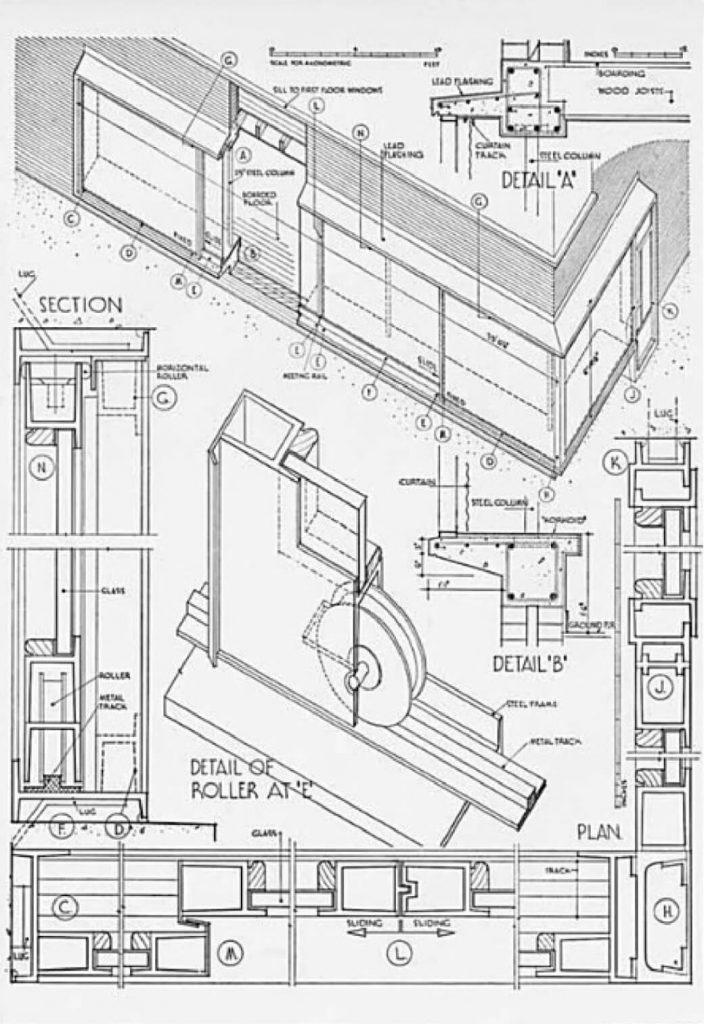article
Modern Movement architects, who took these experiences to the limit, always took advantage of the materials, assembly techniques and new possibilities that the industry offered to architecture. Little wonder, therefore, at the comparison between the metallic profile of an industrialised window and a Bugatti engine on the pages of Vers une Architecture¹⁷. They accepted and incorporated innovative products as new components of their architecture and, in cases where there was a lack of response from the industrial market, studied and developed new systems with relevant architectural features. This is precisely what happened to the horizontal window, for which Le Corbusier and Pierre Jeanneret engineered and promoted châssis coulissants, sliding frames. In July 1926, they patented a sliding window with an unlimited number of free moving sashes¹⁸, which was applied at Villa Cook in Boulogne-sur-Seine (France, 1926-27). And they also developed a set of more than twenty technical solutions for sliding windows, among which a frame in anticorodal, an aluminium alloy, manufactured by Ernst Koller with two parallel Saint-Gobain glasses (1928-29). In 1927, the Parisian architects even signed a commercial contract with Saint-Gobain relating their patent. And they were not the only ones developing sliding metal windows, as in the same period, companies like Artaria & Schmidt in Basel, and Wanner in Geneva were also pursuing that path.¹⁹ Years later, many were the architects and companies doing the same.
This fact testifies the close proximity between the architect’s design work and the development of industrial products in the beginning of the century, a time when science was beginning to allow for properties of the frames to be engineered. Swedish architect Sigurd Lewerentz is perhaps the most vivid example of this close collaboration, having spent his life sharing his work with the development and manufacture of metal window frames. The slender steel profiles and ingenious fittings produced by Idesta, the company he founded in 1929,²⁰ display a rigour and desire for innovation evident in the number of registered patents, and which paradoxically culminated in the use of frameless glass on mural supports in his latest works.
However, horizontal windows also reflect modern architecture’s preference for sliding sashes. Indeed, modern windows’ horizontal shape and lengthwise dimensions matched the reduced thickness of the new walls, imposing a solution in which the opening of the door or window did not subtract useful space in the interior. In addition, because they do not extend beyond the plane of action, sliding solutions are “designed to fill a long-felt want, eliminating the projecting frames of pivoted ventilators, which interfere with shades, screens, etc.” as reported in a 1912 catalogue.²¹ An affordable and relatively little used 17th century variant of a type of sash window used in the Netherland and in Yorkshire was therefore recovered and perfected.²² Sliding doors were an old invention – with examples in ancient Greece and Rome²³ – and quite popular in Great Britain by the end of the 19th century and the beginning of 190024 – especially in salons of Victorian houses –, but its performance in terms of watertightness, acoustics and air permeability were always inferior to those of casement doors and windows (side-hung and top-hung).
This fact limited its application towards the exterior, except in industrial buildings and vehicles. The inevitably reduced opening area compared to the traditional fenêtre en hauteur also seems to justify this fact.
Curiously, decades before Le Corbusier, Dr. Karl Turban and the architect Jacques Gros had already felt the need to adopt a new type of window in their Sanatoriums for the cure of tuberculosis from 1902.²⁵
Folding and sliding doors and windows thus appeared (Fensterkonstruktionsvorschlag), with the particularity of allowing the complete opening of window frames composed of several sashes.²⁶
In any case, the longitudinal shape and large dimensions of the Modern Movement lights, supported by the availability of new materials and their progressive improvement – such as bearings, seals and, especially, larger sheets of glass – legitimised the use of the horizontal sliding window as an invariant throughout Europe in the ensuing decades, particularly in the post-war period.²⁷
The window frames developed by Le Corbusier and Pierre Jeanneret consisted of systems with an unlimited number of sashes and could also include a mechanism for operating the window by a crank, as used in the large steel-framed glass slider of Villa Savoye (Poissy, France, 1928-31) to move a huge 4.65 x 3.5m sash, composed of two panes of 2.3 x 3.5m glass.²⁸ In fact, and additionally, the automation of sliding windows was a fundamental aspect of the Corbusian fenêtre mechanique. This function was already offered for the windows of automobiles, of which Le Corbusier was a great enthusiast.²⁹ It is not surprising, therefore, his call for a car industry’s contribution to the modernisation of building technology, underlining the possibility of mechanical window opening:
“Que Renault, Peugeot, Citroën, que le Creusot ou l’un des grands métallurgistes organisent l’industrie dans le bâtiment! La fenêtre considérée comme une mécanique. Glissement automatique, herméticité. Nous doter d’une fenêtre mécanique! […] Attention! les fenêtres ne doivent plus ouvrir à battants à l’intérieur des chambres qu’elles encombrent, ou à l’extérieur des façades. Elles doivent glisser latéralement (la première seule peut pivoter). […] La fenêtre est l’élément mécanique-type de la maison. On presse un bouton, ou plus simplement, on tourne une manivelle, et les fenêtres glissent doucement, s’ouvrant ou se refermant…” ³⁰
Curiously, in his residence at Herqueville in Normandy (France, 1906-39) – where Jofebar intervened in 2014³¹– Louis Renault himself installed a steel window with two sliding sashes operated mechanically by rack, chain and crank, just like Le Corbusier’s call for action.
